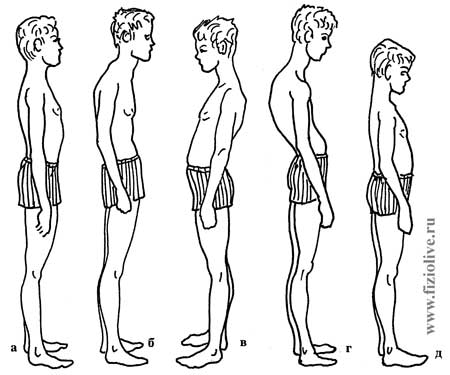
| HOME | MENU | DOCS | SEARCH |
There are following changes in the spine: violation of posture (functional changes, that is, muscle imbalance); scoliosis (structural changes in the vertebrae, intervertebral discs, ligaments, etc..).
Habitual standing posture of the body is called. Normal posture provides a harmonious body structure, the symmetry of its parts, which is an important condition for strong physiological biomechanical each spinal segment support for the overlying card.
The most common curvature of the spine in the frontal plane, ie, scoliosis, which is often combined with a curvature in the sagittal direction (kyphoscoliosis). Mostly there is left-sided scoliosis of a spine. Scoliosis divided in form and degree of manifestation of the deformation. The form of scoliosis distinguish partial and total, as well as an S-shaped (a double), and triple-sided. For scoliosis is characterized by persistent or recurrent back pain, worse with exercise. Typically the lateral curvature of the spine left or right of its centerline, and the greatest bending generally corresponds IX-X thoracic vertebrae (see. Fig. Types of posture).
Types of posture

Types of posture: а — normal; б — a stooping figure; в — lordotic; г — kyphotic; д — rectilinear (flat)
Scoliosis are congenital and acquired. On the stage of the spine changes are four degrees of scoliosis: 1 degree - a slight curvature of the spine in the frontal plane, pronounced asymmetry of the muscles; 2 degree - clearly noticeable lateral curvature of the spine, rib hump is planned; 3 degree - fixed scoliosis, rib hump height of 3 cm, a deviation in the direction of the main body of the arc; Grade 4 - pronounced kyphoscoliosis fixed, a significant deviation in the direction of the body, strongly pronounced rib hump back (see Figure Types posture..).
In its current scoliosis may be non-progressive, slowly progressive and rapidly progressive. Determining the degree of scoliosis allows you to develop the most efficient system of treatment and prevention. The younger the child is ill, the worse prognosis: scoliosis progresses as the child grows. With the progression of scoliosis there is a change on the part of the musculoskeletal system, cardiovascular and respiratory systems, suffer physical development.
Prevention of violations of posture and scoliosis
To prevent violations of posture is necessary to avoid prolonged wearing the baby in her arms, just to teach him to sit and walk. Let baby crawl over or lying on his stomach on a hard bed (see. Fig. The appearance of the spine curves in children). In kindergarten carried hardening, walks, outdoor games, gymnastics, massage and others. (See. Fig. Model systems simulation exercises for children of all ages). It is necessary to continuously monitor the posture of the child at home and school, to organize his working place. In case of violation of posture is carried out special exercises to strengthen the muscles of the abdomen and back, performed gymnastic exercises at the wall, with gymnastic rubber bandages and others.
The appearance of the spine curves in children
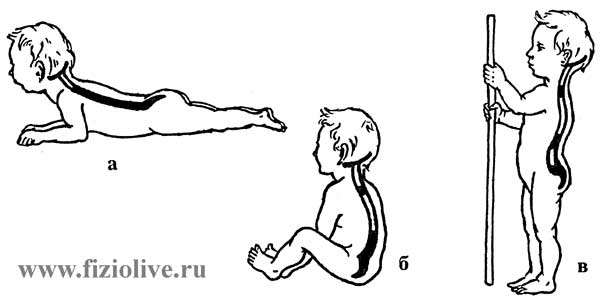
The appearance of the spine bends in children due to the content of the head (a), when the seat (б) and the distance (в)
An exemplary set of simulation exercises in children

A sample set of exercises for preschoolers 3-4 years

A sample set of exercises for preschoolers 5-6 years
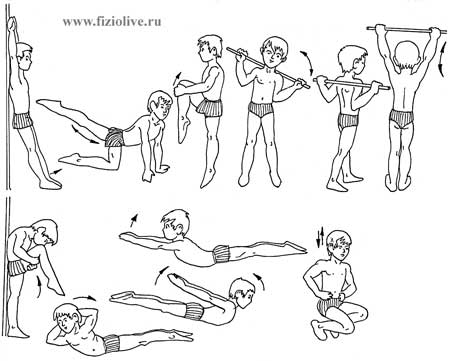
Many exercises are performed in the supine position and reclining, as the spine should be spared (see. Fig. A sample set of therapeutic exercises (LH) in violation of posture).
The approximate range of therapeutic exercises in violation of posture
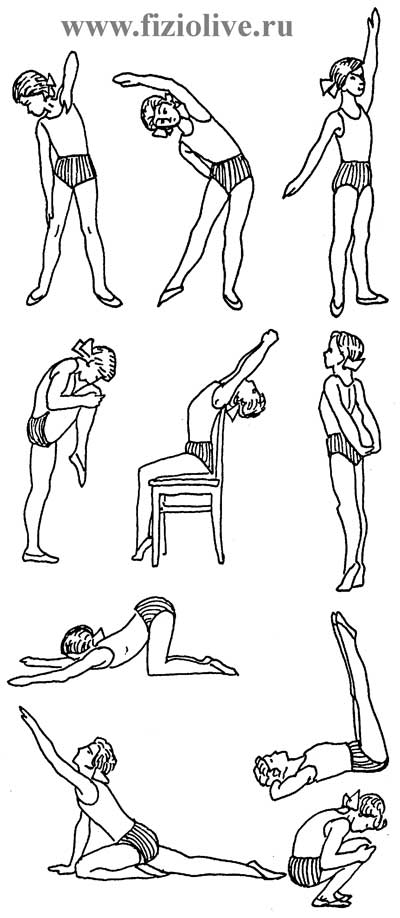
If you have carried out comprehensive treatment of scoliosis: physiotherapy (see Figure A sample set of therapeutic exercises in spinal scoliosis..), Diet, massage, physiotherapy and hydrotherapy, therapeutic swimming, skiing, corrective bed, plaster corsets (with the progression of the disease).
The approximate range of therapeutic exercises in the spine scoliosis
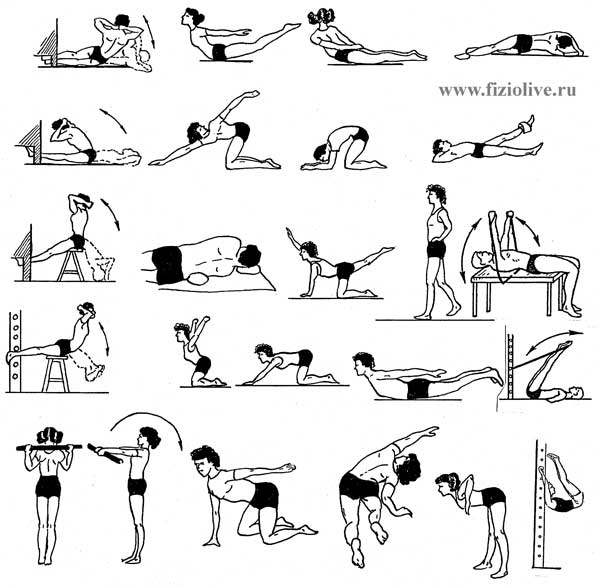
Full range of treatment is aimed at reducing the strain, the suspension of its progression, compensation and stabilization using LFK - strengthening muscles to form the so-called "muscular corset". Krome that include physiotherapy, massage, treatment provision and laying to unload the spine and deformity correction.
The technique of massage. In the 1 st and 3 degrees of scoliosis partly held back massage of the lower limbs, abdomen. Thoroughly massage the muscles of the back. 60-70% of the time is devoted to kneading. Duration of the massage for 15-20 minutes every day, the course of 20-30 procedures. In the year of the course 3-4. Massage is carried out in conjunction with the LFK (see. Fig. A sample set of therapeutic exercises in spinal scoliosis). The situation during the massage - prone (on the hard couch or massage table). Excluded methods: hack, effleurage. Includes vibratory massage and traction on the panel, as well as exercises and lying hydrocolonotherapy.
When scoliosis is recommended therapeutic swimming. therapeutic swimming Objectives: acquisition of a normal posture, spinal correction, development of proper breathing, increase strength and muscle tone, improving the function of the cardiovascular system, hardening of the body, the acquisition of swimming skills.
Methods of therapeutic swimming. Swimming for children with 1-3 stages of scoliosis. Initially engaged in the hall ("dry swimming"), then with water. 8-10 people Groups are formed according to age, diagnosis, clinical course of the disease, etc. medical navigation procedure is based on the standard scheme: introduction, main and final part. Classes are held at least 3 times a week in the indoor pool at a water temperature of 28°C and 25-26°C air. The total duration of employment 40-45 minutes. Also included are a variety of exercises:.. Swimming fins on board and others perform exercises with the rubber bumpers, dumbbells (with special floats), ball games and other therapeutic. School sailing lasts 10 months.
Contraindications: progressive form of the disease, acute and chronic skin diseases, diseases of upper respiratory tract, eyes, and others.
V.I. Dubrovsky,
Academician of the Russian Academy of Natural Sciences,
IANPO and the New York Academy of Sciences,
Doctor of Medical Sciences, Professor,
A.V. Dubrovskaya, pediatrician
<< Back: Rehabilitation in children (Pediatrics)
We recommend that you look at the popular sections of the site myvaleology.com: MENU with a description of the sections | |||
| SOCIAL | DONATION | MY DIET | MY SPORT |

|
Release all4e8 |
||
Copyright © VZOJ 2023. All rights reserved. When reprinting or quoting myvaleology.com materials please put a link to the site myvaleology.com :
<a href="https://myvaleology.com">Healthy lifestyle</a>